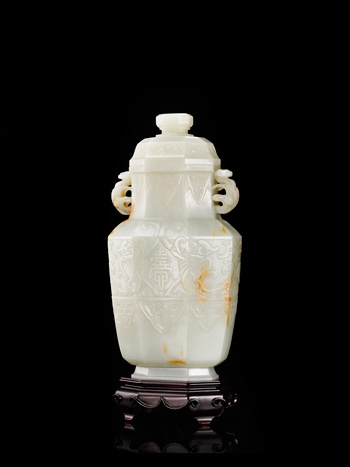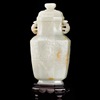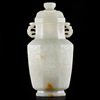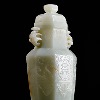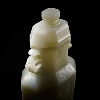PROVENANCE: Formerly in the collection of Mr. Cai Chen Nian During the patronage of Qianlong in particular, jades were primarily the indulgences of the Imperial family and the aristocracy. In contrast to the crafts of ceramics or porcelain, there are no two jades with identical components as the variations in physical properties, coloration and naturalistic inclusions are seemingly endless and this inconsistency contributes to its aesthetic value. The present lot of a functional object for daily use or for the connoisseurship of delightful pursuit epitomizes the prevalent style at the time. Although vases varied in shape and style, they were fundamentally shaped with a relatively small mouth, broad shoulders and a wide girth. The technique of hollowing the interior through the narrow opening of the mouth testified to the accomplishments of the Qianlong craftsmen. Moreover, the design of the present lot draws its creative inspiration from ancient forms and styles, commonly referred to as Fanggu, which literally translate to the imitation of antiquity. Archaistic vases such as the present lot were likely to have been modeled after early bronzes, and incorporated ancient motifs such as the leiwen, archaic stylised dragons as well as the elongated blade like patterns resembling banana leaves while the central shou (longevity) character set in between the chilongs reinforces the simplicity of the decoration and extenuates the natural beauty of the stone. The manipulation and added coloring of the russet inclusions on the vessel further testifies to the commitment in imitating the ancient form. Compare with a wine vessel with a very similar stylized dragon and shou character from the Collection of Sir Bernard Eckstein, illustrated in Stanley Knott, Chinese Jade throughout the age, pl. CIV, p.127. Another vase worked with the motif of archaistic dragons and further flanked by loose handles is currently residing at the National Palace Museum in Taipei, illustrated in Masterworks of Chinese jade in the National Palace Museum, Taipei, 1973, pl.147, p.180. Another vase bearing a centralized shou character in the Metropolitan Museum of art, illustrated in Chinese jade of five centuries, Metropolitan Museum of Art, 1969, pl.31, pp. 116-117. Compare also with a jade box bearing the same shou character sold in Sotheby’s Hong Kong, 18 May 1989, lot 751.
|
8089
A RARE WHITE NEPHRITE SHOU CHARACTER VASE AND COVER
QIANLONG AND OF THE PERIOD (1736-1795) |
|
Of octagonal form, carved in low relief on two sides with a shou character framed by archaistic dragons above a band of pendent leaf tips on the neck interrupted by ruyi-sprig handles, the matching cover surmounted by a knop finial, with opaque white mottling throughout and some areas of added russet coloring. |
|
Estimate
6,000,000 - 8,000,000 23,438,000 - 31,250,000 773,200 - 1,030,900
|
|
Sold Price 7,200,000
27,906,977
929,032
|
|
|
PROVENANCE: Formerly in the collection of Mr. Cai Chen Nian During the patronage of Qianlong in particular, jades were primarily the indulgences of the Imperial family and the aristocracy. In contrast to the crafts of ceramics or porcelain, there are no two jades with identical components as the variations in physical properties, coloration and naturalistic inclusions are seemingly endless and this inconsistency contributes to its aesthetic value. The present lot of a functional object for daily use or for the connoisseurship of delightful pursuit epitomizes the prevalent style at the time. Although vases varied in shape and style, they were fundamentally shaped with a relatively small mouth, broad shoulders and a wide girth. The technique of hollowing the interior through the narrow opening of the mouth testified to the accomplishments of the Qianlong craftsmen. Moreover, the design of the present lot draws its creative inspiration from ancient forms and styles, commonly referred to as Fanggu, which literally translate to the imitation of antiquity. Archaistic vases such as the present lot were likely to have been modeled after early bronzes, and incorporated ancient motifs such as the leiwen, archaic stylised dragons as well as the elongated blade like patterns resembling banana leaves while the central shou (longevity) character set in between the chilongs reinforces the simplicity of the decoration and extenuates the natural beauty of the stone. The manipulation and added coloring of the russet inclusions on the vessel further testifies to the commitment in imitating the ancient form. Compare with a wine vessel with a very similar stylized dragon and shou character from the Collection of Sir Bernard Eckstein, illustrated in Stanley Knott, Chinese Jade throughout the age, pl. CIV, p.127. Another vase worked with the motif of archaistic dragons and further flanked by loose handles is currently residing at the National Palace Museum in Taipei, illustrated in Masterworks of Chinese jade in the National Palace Museum, Taipei, 1973, pl.147, p.180. Another vase bearing a centralized shou character in the Metropolitan Museum of art, illustrated in Chinese jade of five centuries, Metropolitan Museum of Art, 1969, pl.31, pp. 116-117. Compare also with a jade box bearing the same shou character sold in Sotheby’s Hong Kong, 18 May 1989, lot 751.
